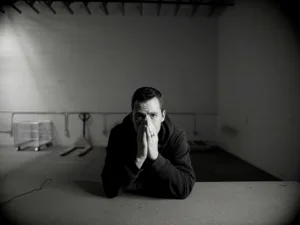Trauma impacts men twice: the moment of the experience and then not being able to talk about it.
Take this all too common example, a school-age boy experiences repeated bullying at school. He then gets the courage to talk to his father about it. The boy tearfully tells his father that he is scared to go to school. His father responds, “quit your bitching and be a man about it.” The message is loud and clear: real men must be strong at all times, having emotions is a sign of weakness. Don’t talk about it. Doing so makes you a woman, not a man. The boy will often feel shame because he is fearful of the bullying and he showed his father his emotions. The boy learns that a real man cuts himself off from his feelings, stays quiet and suffers alone. This common chain of events results in two traumas; bullying and shaming.
One therapy that is particularly effective for the type of trauma described above is Eye Movement Desensitization and Reprocessing (EMDR) therapy.
EMDR therapy is an integrative psychotherapy approach designed to treat a wide array of psychological issues. For men, EMDR therapy for men can be a game changer.
What is EMDR Therapy?
EMDR therapy is a depth psychotherapy that focuses on memory. From the EMDR perspective, psychological symptoms are related to the failure to adequately process traumatic memories. What we believe happens is that these overwhelming memories and experiences get frozen in the nervous system along with the emotional charge, thoughts, sensations, and urges, associated with that original experience.
When we experience a present-day trigger related to the trauma memory, it can reactivate that collection of experiences leading to symptoms. Due to this freezing of the memory, the brain’s information processing system is unable to process the experience, so when a person gets triggered, the past becomes the present. With EMDR therapy we find the memories, both past and present along with current triggers that are stuck and need to be reprocessed with EMDR therapy. In other words, EMDR therapy helps the memory become unstuck or unfrozen allowing the brain to adequately process the memory. When this happens there are no longer psychological symptoms.
According to the EMDR Research Foundation, EMDR therapy for trauma has been widely researched and verified by over three dozen controlled research studies. The research on EMDR also suggests that it is an effective treatment for depression, addictions, and anxiety disorders. It is also highly recommended by the World Health Organization (WHO) and the International Society for Traumatic Stress Studies (ISTSS).
EMDR Therapy For Men
Structured Approach
EMDR therapy follows an eight-phase process that provides a predictable and organized therapeutic experience. This structured framework appeals to many men who prefer clear guidelines and measurable progress in therapy.
The eight phases include:
- History taking and treatment planning
- Preparation and building coping skills
- Assessment of target memories
- Desensitization using bilateral stimulation
- Installation of positive beliefs
- Body scan to identify residual tension
- Closure to ensure stability between sessions
- Evaluation of progress
This phase approach gives men a roadmap for their therapeutic journey, making the process less ambiguous and more approachable.
Action-Oriented Process
Unlike traditional talk therapy, EMDR involves concrete actions – following the therapist’s hand movements, tapping, or listening to alternating tones. This active participation aligns with some men’s action oriented style and provides a tangible way to engage with therapy.
Building On Strengths
EMDR for men is a strengths-based therapy. Rather than focusing on the so-called “deficits” of masculinity, we believe masculinity has many positive aspects. We work to identify and build on your strengths as a man. EMDR also promotes post-traumatic growth.
I Don’t Want To Talk About It
Many men do not want to have long open-ended discussions of painful life experiences. EMDR therapy doesn’t require detailed verbal descriptions of traumatic experiences or prolonged emotional discussions. Instead, it focuses on reprocessing memories through bilateral stimulation, which can be particularly beneficial for men who struggle to or do not want to verbalize their feelings.
Privacy and Control
EMDR offers a safe and controlled environment where men can process emotions without feeling exposed or judged. The therapy allows for emotional processing without requiring extensive discussion of feelings, which many men find reassuring and less threatening than other therapeutic approaches.
Breaking Down Barriers In Therapy
Traditionally, men are expected to be publicly strong and not allowed to show any vulnerability. Some men suppress or minimize painful and traumatic experiences as a way of coping or to avoid feeling judged. In reality, suppressing these experiences and feelings prevents them from processing grief, anxiety, trauma or life transitions.
These are just some of the barriers men face when starting therapy. Fortunately, EMDR therapy addresses each of these common concerns:
“What if therapy is like Pandora’s box? If I start to talk about my feelings, I’ll open the floodgates and never be able to stop.”
Early on in EMDR therapy men learn calming and containment strategies. This means they learn skills to calm and then contain or put away distressing memories, thoughts, and feelings. This gives men the confidence to explore difficult emotions and experiences, but also have the skills to return to their baseline. Therefore, this will not be like Pandora’s box, they can open up the box and then learn to close it again.
“Therapy seems so open-ended. How can talking about the problem fix the problem?”
EMDR therapy is a structured, phase-oriented therapy focused on symptom reduction. This means you always know where you are in the therapy process. This also means this therapy is action-oriented by working on past, present and future memories that are contributing to current symptoms.
“I don’t remember having trauma. How will I know what’s causing my symptoms?”
Often men come to therapy unaware of the root cause of their symptoms. EMDR Therapy for men often starts with education on how current symptoms like anxiety, depression or anger are often rooted in past negative experiences. A trained EMDR therapist can assist the client in uncovering these memories. For some men who struggle to remember trauma in their past, these memories will often spontaneously emerge during the safety of the therapy work.
“My life hasn’t been that hard. Why can’t I just deal with it on my own?”
Due to difficulties some men have with communicating feelings, untreated trauma may silently creep up on them. This is especially common with challenges in relationships and employment rather than more obvious causes such as experiencing war. The pressure to be strong and in control can prevent many men from seeking help. EMDR can safely and quickly identify and resolve the roadblocks in your life, and help you develop healthy coping mechanisms.
How EMDR Benefits Men’s Mental Health
Addressing Root Causes
EMDR therapy helps men understand how current symptoms like anxiety, depression, anger, or relationship difficulties often stem from past negative experiences. By targeting these root causes, EMDR offers long-lasting relief rather than just managing symptoms.
Skill Development
During the preparation phase of EMDR, men learn valuable self-regulation techniques and coping strategies. These skills help manage distressing memories and emotions both during and between therapy sessions, providing a sense of mastery and control that many men value.
Processing Trauma Without Reliving It
EMDR allows men to process traumatic memories without having to relive them in detail. This approach can be particularly helpful for men with military backgrounds, first responders, or those who have experienced childhood trauma who may be reluctant to discuss painful experiences extensively.
How Does EMDR Therapy Work?
The eight stages of EMDR therapy are listed below:
1. History and treatment planning. As the first step, your history is taken, and a treatment plan is established. This phase includes a discussion of the specific concern that brought you into treatment, as well as the behaviors and symptoms that resulted from that problem. Past memories, current triggers and future goals are noted.
2. Preparation. The second stage helps develop trust between you and the therapist. You’ll be introduced to the procedure in detail so that you know what to expect, and so that you can remain relaxed and confident during treatment. You will also identify and build on the positive experiences and strengths that you have as a man. You’ll also be taught techniques that you can practice in between sessions to handle distress.
3. Assessment. The therapist will help you to notice various aspects of a certain memory during this phase. This could be a childhood experience of your family, or it could be something more recent.
4. Desensitization. Here, you’ll focus on the negative memory while simultaneously engaging in bilateral stimulation such as eye movement. Depending on your response, the therapist may change the length, type and speed of stimulation used. The memory will be reprocessed until all feelings of distress are diminished.
5. Installation. During this phase, a positive response to the memory is installed and strengthened to replace the initial adverse reaction. For example, you may feel strong and capable of resisting the trauma.
6. Body scan. Next, the EMDR therapist will observe whether thinking about the memory elicits any other physical response, such as increased pulse or muscle tension. If there is any tension remaining, desensitization will repeat.
7. Closure. Closure ensures that you leave each session feeling better than when you arrived. If the processing of the traumatic target event cannot be completed in a single session, the therapist will help you regain a sense of stability by using a number of self-calming techniques.
8. Reevaluation. During the start of each session, the therapist determines if the positive results have been maintained and identifies any new areas that require attention. This phase is helpful in identifying the treatment plans that are required to address the problems. Like any other form of therapy, reevaluation is critical in determining the treatment’s success over time.
The treatment will be complete when unpleasant memories have been addressed, and any disturbing responses you had been experiencing in present situations are reduced or eliminated.
What Does EMDR Treat?
EMDR therapy focuses on eye movements as the key to your healing. Although it may seem unusual, it’s extremely effective.
EMDR therapy was initially designed to help with traumatic memories; however, it has shown to be beneficial for numerous other issues, including:
-
- Depression
-
- Post-traumatic stress disorder (PTSD)
-
- Anxiety
-
- Panic attacks
-
- Phobias
-
- Low self-esteem
-
- Substance abuse
-
- Pain management
-
- Sleep difficulty and nightmares
Other ways EMDR can Help
Help overcome stress, anxiety and depression. Men handle depression, anxiety, stress and other life challenges in a unique way. They also experience mental health symptoms differently than women. EMDR trauma therapy for men can help reverse the damage from conditions such as anxiety and depression, and equip men for future life challenges.
Help with addiction. Men who go through trauma are more likely to develop addictions. In fact, PTSD is one of the most common causes of addiction — but thankfully, treating the root cause can lower the risk of relapse.
Provide therapeutic relief for athletes. When athletes have a traumatic experience on or off the field, the negative emotions associated with that event might seep into their mind and affect their performance. EMDR allows them to revisit the stressful or traumatic incident and reprocess it using positive visualization techniques. This decreases unfavorable expectations and allows the athlete to focus on the task at hand without fear or pessimism.
Finding a Male-Friendly EMDR Therapist
When seeking an EMDR therapist, men may want to consider:
- A therapist’s experience working with male clients
- The therapist has completed a EMDRIA approved basic training.
- Their understanding of men’s unique challenges in therapy
- Their approach to explaining and implementing EMDR
- Whether they create a non-judgmental environment
Many EMDR therapists offer consultation sessions where potential clients can assess their comfort level before committing to therapy.
At Denver Men’s Therapy we have female and male EMDR therapists who are also trained in male focused therapy.
Conclusion
EMDR therapy offers a male-friendly approach to mental health treatment through its structured, action-oriented process that doesn’t rely heavily on verbal emotional expression. Its efficiency, focus on processing rather than extensive talking, and emphasis on tangible progress make it particularly appealing to men who might otherwise avoid therapy.
By providing a clear framework, concrete techniques, and a safe environment for processing difficult experiences, EMDR helps men address underlying trauma and develop healthier emotional responses – ultimately improving their overall well-being and quality of life.














